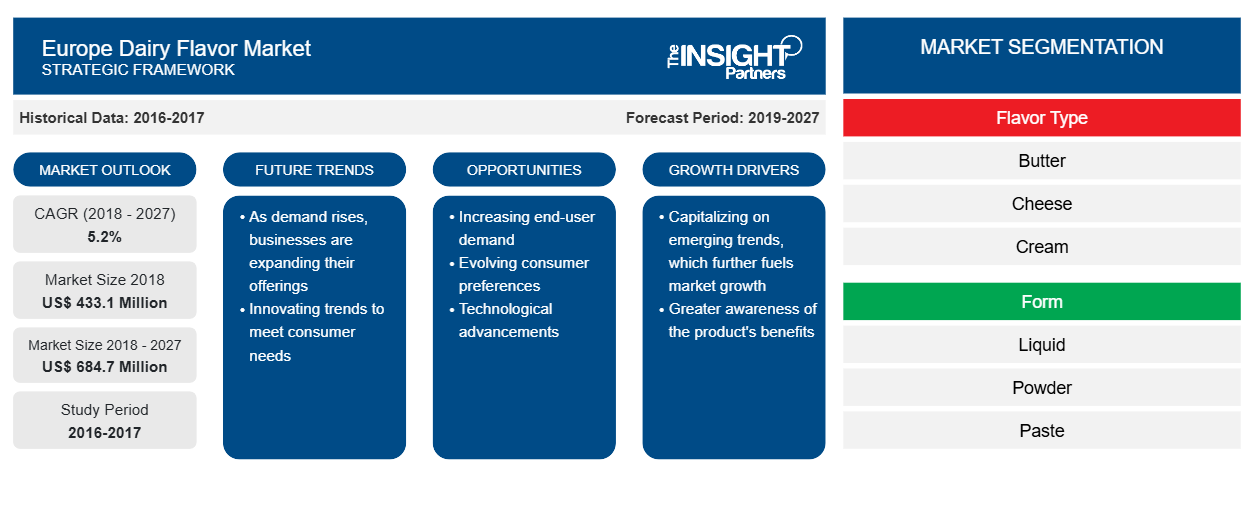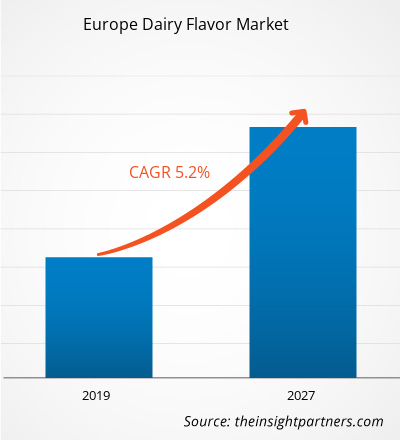The Europe dairy flavor market was valued at US$ 433.1 million in 2018 and is projected to reach US$ 684.7 million by 2027; it is expected to grow at a CAGR of 5.2% during the forecast period 2018-2027.
Dairy flavors are processed from different types of dairy products such as milk, cheese, yogurt, butter, and cream. The organoleptic properties of dairy products, together with the growing awareness among the consumers of being healthy, make these products one of the essential ingredients in the food &beverages industry. The dairy flavors are often combined with many other characterizing flavors to deliver a completely new and unique taste to the final product. The manufacturers focus toward developing new dairy-based flavors owing to the rising demand from consumers to consume organic and natural flavors. The dairy flavors help in cutting costs as they proffer similar taste and aroma as that of the original dairy product despite reducing the usage of the volume of the product. They also provide subtle dairy notes such as moldy, pungent, and astringency by increasing their functionality. On one hand, these dairy flavors appear as a flavor on the ingredient statements, while on the other, they may be labeled depending upon the dairy product name from which they are made.
The UK contributed to the largest share of the Europe dairy flavor market. The UK is another attractive region for dairy flavors products and provides several rewarding opportunities to manufacturers and producers. Dairy flavors-based food and beverages are commonly consumed such as flavored ice creams and yoghurts. The diversification in the application base of dairy based flavor products has created a significant impact on the demand of dairy flavors in the UK market.
Impact of COVID-19 Pandemic on Dairy Flavor Market
COVID-19 outbreak first began in Wuhan (China) in December 2019, and since then it has spread across the globe at a fast pace. China, Italy, Iran, Spain, the Republic of Korea, France, Germany, and the US are among the worst affected countries in terms of confirmed cases and reported deaths as of March 2020. The COVID-19 outbreak has affected economies and industries in various countries due to lockdowns, travel bans, and business shutdowns. The overall market breakdown due to COVID-19 is also affecting the growth of the dairy flavor market due to shutting down of factories, obstacle in supply chain, and downturn in world economy.
Europe Dairy Flavor Market
- This FREE sample will include data analysis, ranging from market trends to estimates and forecasts.
Market Insights
Health benefits of dairy flavors
Dairy flavors like flavored milk, butter, cheese, and yogurt offer various health benefits on consumption. Flavored milk has different types of nutrients such as potassium, calcium, protein, magnesium, vitamin A, B2, and D. Besides, it adds only 3% of added sugar in the diets of children of the age group from 2 to 18. Yogurt flavors, when added to food, improve skin quality and immunity, helps in reducing high blood pressure, and is suitable for digestion. Since yogurt is made from low fat or fat-free milk, the flavors made from yogurt are rich in calcium. Creamy flavors are rich in energy with fat and fat-soluble vitamins like vitamins A, D, and K. Clarified butter or ghee when added to food reduces the exposure to cancer-causing agents. Buttermilk, when consumed, helps in lowering cholesterol and fights cholesterol. The concentrated dairy flavor can be utilized around 0.1% to 1% in terms of volume, diminishing the dairy content yet retaining the taste of the original dairy product with which it is made. Thus, the health benefits associated with dairy flavors drives the market growth in Europe.
Flavor Type-Based Market Insights
Based on flavor type, the dairy flavor market is segmented into milk, butter, cheese, cream, yogurt, and others. The milk segment accounted for the largest share of the Europe dairy flavor market in 2018; however, the market for the cheese segment is expected to grow at the highest CAGR during the forecast period. Milk flavor is a result of a balance composition of numerous compounds that are originated through complex metabolic pathways. Milk is slightly sweet in taste, has very little odor, and gives a rich feel in the mouth. As milk is bland in flavor, minute quantities of abnormal constituents present in it result in off-flavors. Different milk flavors, such as feed and weed flavors, oxidized flavor, and light activated milk flavors, are available in the market.
Europe Dairy Flavor Market, by Flavor Type– 2018 and 2027
- This FREE sample will include data analysis, ranging from market trends to estimates and forecasts.
Form-Based Market Insights
Based on form, the dairy flavor market is segmented into liquid, powder, and paste. In 2018, the liquid segment accounted for the largest share of the Europe dairy flavor market; whereas, the powder segment is expected to register the fastest CAGR during the forecast period. A wide variety of dairy flavors in liquid form are available in the market. Melted butter is used in the formation of ghee, also known as clarified butter, which is further used as a flavor in different types of food. It not only adds flavors but also helps in decreasing unhealthy cholesterol and improving memory. Liquid butter serves as a useful ingredient for dipping seafood and for making hollandaise and other types of sauces. Butter in liquid form can be stored in refrigerators for months.
Application-Based Market Insights
Based on application, the dairy flavor market is segmented into bakery, confectionery, soups and sauces, beverages, dairy products, and others. In 2018, the beverages segment dominated the Europe dairy flavor market; whereas, the dairy products segment is expected to grow at the fastest rate during 2019–2027. The subtle taste of dairy flavors enhances the drink by adding richness and texture. They also add additional taste or simply depth to a variety of beverages. Different dairy flavors are responsible for adding coffee concentrates, chocolate mixes, and sweetness to yogurt-based drinks.
Customize This Report To Suit Your Requirement
You will get customization on any report - free of charge - including parts of this report, or country-level analysis, Excel Data pack, as well as avail great offers and discounts for start-ups & universities
Europe Dairy Flavor Market: Strategic Insights

-
Get Top Key Market Trends of this report.This FREE sample will include data analysis, ranging from market trends to estimates and forecasts.
Product development, merger and acquisition, and business planning are the commonly adopted strategies by companies to expand their product portfolio. Ornua is among the market players implementing these strategy to enlarge the customer base and gain significant market share in Europe, which, in turn, permits them maintain their brand name in the Europe market.
Report Spotlights
- Progressive industry trends in the Europe dairy flavor market that help players develop effective long-term strategies
- Business growth strategies adopted by developed and developing markets
- Quantitative analysis of the Europe dairy flavor market from 2017 to 2027
- Estimation of Europe dairy flavor demand across various industries
- PEST analysis to illustrate the efficacy of buyers and suppliers operating in the industry to predict market growth
- Recent developments to understand the market competition in Europe
- Market trends and outlook, coupled with factors driving and restraining the growth of the Europe dairy flavor market
- Decision-making process by understanding strategies that underpin commercial interest with regard to the Europe dairy flavor market growth
- Europe dairy flavor market size at various nodes of market
- Detailed overview and segmentation of the Europe dairy flavor market, as well as its dynamics in the industry
- Europe dairy flavor market size in various regions with promising growth opportunities
Dairy Flavor Market – By Flavor Type
- Milk
- Cheese
- Cream
- Yogurt
- Butter
- Others
Dairy Flavor Market – By Form
- Liquid
- Powder
- Paste
Dairy Flavor Market – By Application
- Beverages
- Confectionary
- Soups and Sauces
- Bakery
- Dairy Products
- Others
Company Profiles
- CP Ingredients
- Dairy Chem Inc.
- The Edlong Corporation
- Kerry Group
- Ornua Co-operative Limited
- H.E Stringer Flavours Limited
- Synergy Flavors
Europe Dairy Flavor Market Report Scope
| Report Attribute | Details |
|---|---|
| Market size in 2018 | US$ 433.1 Million |
| Market Size by 2027 | US$ 684.7 Million |
| CAGR (2018 - 2027) | 5.2% |
| Historical Data | 2016-2017 |
| Forecast period | 2019-2027 |
| Segments Covered |
By Flavor Type
|
| Regions and Countries Covered |
Europe
|
| Market leaders and key company profiles |
|
Europe Dairy Flavor Market Players Density: Understanding Its Impact on Business Dynamics
The Europe Dairy Flavor Market is growing rapidly, driven by increasing end-user demand due to factors such as evolving consumer preferences, technological advancements, and greater awareness of the product's benefits. As demand rises, businesses are expanding their offerings, innovating to meet consumer needs, and capitalizing on emerging trends, which further fuels market growth.

- Get the Europe Dairy Flavor Market top key players overview
- Historical Analysis (2 Years), Base Year, Forecast (7 Years) with CAGR
- PEST and SWOT Analysis
- Market Size Value / Volume - Regional, Country
- Industry and Competitive Landscape
- Excel Dataset
Recent Reports
Testimonials
Reason to Buy
- Informed Decision-Making
- Understanding Market Dynamics
- Competitive Analysis
- Identifying Emerging Markets
- Customer Insights
- Market Forecasts
- Risk Mitigation
- Boosting Operational Efficiency
- Strategic Planning
- Investment Justification
- Tracking Industry Innovations
- Aligning with Regulatory Trends






















 Get Free Sample For
Get Free Sample For